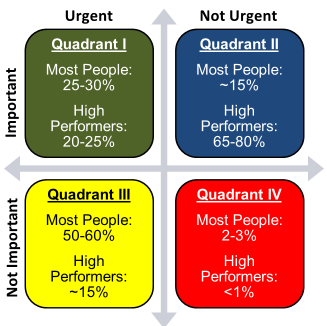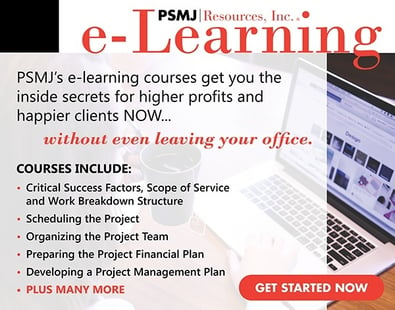 To maximize personal productivity, project managers should strive to become high performers—as described by Stephen Covey in his book, The Seven Habits of Highly Effective People.
To maximize personal productivity, project managers should strive to become high performers—as described by Stephen Covey in his book, The Seven Habits of Highly Effective People.
As indicated in this chart sourced from Covey's well-known book, it seems that most people as well as high performers spend equal amounts of their time in the upper left-hand corner, Quadrant 1, i.e., where everything is important and urgent.
For project managers, a lot of activities reside here: last minute deadlines, final presentations that are going to be done on the next day or two, a proposal that’s due, or a kick-off meeting on a project. There’s always a contractor claim or crisis, or a client calls with a critical issue.
And yet, while both high performers and most people spend a significant amount of their work week doing what is urgent and important, there is a difference between high performers and most people. Most people spend at least 50 percent of their time in Quadrant 3, where what is thought to be urgent is, in actuality, not important. Meanwhile, high performers spend only 15 percent of their time in that lower left quadrant.
For example, a lot of the emails that you’re ready to write now reside in Quadrant 3, because they appear to be so urgent with the speed of light transmittal. There is also the addictive nature of email, which even scientists have found sends a shot of dopamine into your brain every time you answer one. So, of course, you want to answer emails, but a lot simply aren’t that necessary.
And so, as a project manager, you should wean yourself off the tendency of most people, and migrate into the upper right corner where high performers reside most of the time. This is Quadrant 2, where activities are important, but not particularly urgent.
For project managers, such activities may include calling your clients to resuscitate a client relationship or getting more involved in business development. Both activities enable you to grow your performance and participation in your firm to a higher level, i.e. to become a high-performing project manager.
Personal Productivity is just one of the numerous topics covered in PSMJ's series of e-learning project management training courses for new and seasoned A/E/C project managers.
You also might be interested in these project management-related blog posts:
4 Essential Project Management Tips for A/E Professionals
10 Tips for Effective Project Management with BIM




